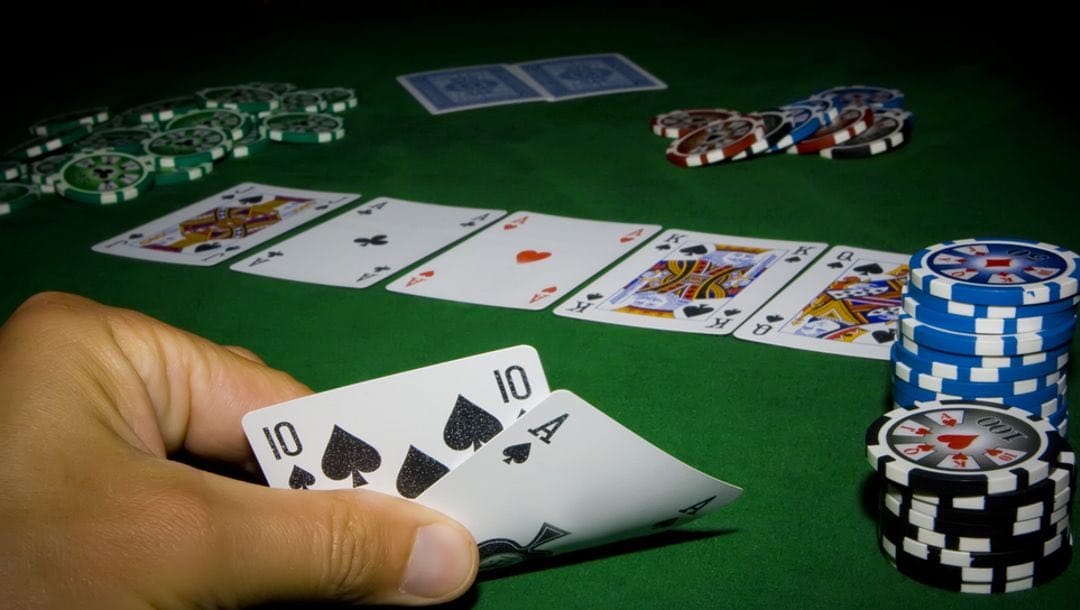
In flop-based poker games, like hold’em and Omaha, each hand is divided into four stages. Players can bet at the start of a game immediately after receiving their hand. This is followed by three more betting rounds: the flop, turn, and river. The same structure always applies, whether you’re playing in poker tournaments or cash games.
In order to maximize your poker playing abilities, you need to understand that each round has its own strategy elements. This blog post contains advice specific to turn-card situations. You’re about to learn exactly what that means and how to play in different spots.
What Is the Turn in Poker?
The turn is essentially the third stage of play in a poker hand. It’s where the dealer reveals the fourth community card, known as the “turn card” or “third street” in poker terminology.
After betting finishes following the flop, another card is taken from the deck and placed face-up on the table. This turn card is quite a significant one — it’s where players will truly understand the strength of their hand.
It’s unclear where the name of this betting street comes from. However, some poker players believe that it might be because it’s where a hand can really “turn.” A player hitting their draw, for instance, swinging the balance of power in their favor and away from their opponent.
The turn is the penultimate poker betting round, so it needs a lot of careful consideration. You need to think like a pro poker player and plan ahead if you want to make the most out of your hand.
Other Poker Streets
The full list of betting rounds in a poker game runs as follows: preflop, flop, turn, river. The preflop stage is where the action begins, taking place before the community cards are revealed.
After that initial betting round, the dealer lays out the first three community cards on the table, and the board begins to take shape. This is known as the flop. Next comes the turn card, followed by the final card, known as the “river.”
At this stage, everyone knows their final hand. Good players will have a solid idea of what their opponents might have in their range, too. Weaker players might focus on how to play during the flop or river, but the turn is equally important for you to develop your strategy.
The Turn Poker Strategy
Poker strategy is important since every decision you make can mean the difference between losing your stack and taking down the pot. Unlike other casino games, it’s you versus other players, and the choices you make affect your chance of success.
There is no “one size fits all” poker strategy. The right decision at any moment will depend on your hand, table position, the betting street, and your experience level, among other factors.
Essentially, you have to think about the turn as a continuation of the flop. The major difference is that the stakes are higher. You could easily end up committing a large stack of your chips, so it’s imperative that you get your strategy right. Here are some examples of common situations when you play Texas hold’em online and how to approach them.

You Have a Strong Hand
When you have a strong hand, you need to maximize your potential winnings. At this point, it’s unlikely you have enough information on your opponents’ ranges to truly know if they have you beaten. Therefore, you should generally continue to bet and build the pot. The obvious exception is if you believe an opponent has just hit a draw.
If your opponent reacts to your bet with a raise, you may need to reassess the strength of their hand. It’s quite rare that a player will raise on the turn unless they have a very strong hand. Consider how they’ve been playing so far and whether it’s possible they might be bluffing. This is slightly harder to do when you play poker online, as you cannot pick up on physical tells. But it’s not impossible.
You’re Bluffing With a Weak Hand
If you bluff with a continuation bet on the flop and your opponent calls, it puts you in a difficult situation. Do you persist with your bluff and fire again on the turn or simply let it go? Continuing your bluff may pay off, but it really depends on your opponent and your table image.
In most situations when playing turn poker, it’s best to check and fold to any action. Hopefully, you’ll get to see the river without committing any more chips to the pot. However, you should be prepared to fold to any aggression from your opponent. You might be able to force your opponent to fold with a large bet, but this is a very risky move.
You Called for a Draw and Missed
In many cases, you might be hoping for a draw that doesn’t happen. If you missed your draw on the turn, your strategy won’t change from the previous street. You have just one card left to hit the draw, and your goal should be to see the river as cheaply as possible. That means checking where possible and folding to any strong bets.
When facing a bet, don’t be tempted to call unless your implied odds make it worthwhile. In the majority of situations, it’s always going to be more profitable to fold in the long term.
To Play Poker, Turn Up at BetMGM
Poker is an easy game to learn, but it’s difficult to master. The turn can be a complex stage, as there are many different variables to consider. However, these tips will help improve your chances in common situations.
If you want to start playing online poker games for real money, you need to register at BetMGM. With dozens of cash game tables to join, not to mention daily tournaments at a variety of stakes, there’s never been a better time to start.
Learn everything you need to know about the turn card in poker, including some essential strategy tips to improve your game.


